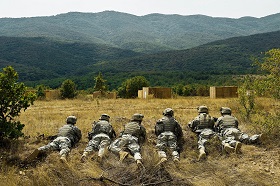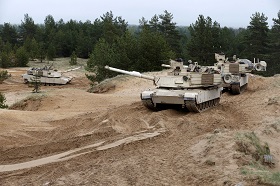The United States, skillfully taking advantage of the phobias and vulnerabilities of countries that until just recently had been part of the socialist bloc, is considering the possibility of taking the military and political confrontation with Russia to a new level.
Prospects for the deployment of U.S. heavy weapons in the countries of ‘new Europe’
The United States, skillfully taking advantage of the phobias and vulnerabilities of countries that until just recently had been part of the socialist bloc, is considering the possibility of taking the military and political confrontation with Russia to a new level.
When information was leaked to the media in mid-July 2015 about the possible deployment of a U.S. military arsenal in Hungary, the Hungarian public had virtually no reaction whatsoever to this news. These reports were only published in one newspaper and have not been covered since by any other publications, as the dominant news topics of the day (and week) have been the scorching heat and the construction of a fence along the Serbian-Hungarian border. To date, the subject of deploying U.S. military hardware has not been widely discussed in Europe despite the potential serious consequences of this initiative by the Pentagon, particularly with regard to relations between Russia and NATO.
The U.S. project officially became known a month prior in mid-June 2015, when The New York Times published an article reporting on the Pentagon’s plans to place combat tanks, infantry vehicles and other types of heavy weapons in Baltic and Central European countries to “meet the needs” of the 5,000-strong U.S. contingent there. If all the parties agree to this – and virtually nobody can influence the negotiating process, this will mark the first time heavy weapons have been deployed on the territory of countries of the former socialist bloc.
The need to implement this project is attributed to historical analogues: the function of deploying heavy weapons has been compared with the organization of the Berlin Brigade in 1961 at the height of tensions between the Soviet Union and the U.S. and also with the weapons stockpiles deployed by the Pentagon in Kuwait “in advance” and used during Operation Desert Storm.
Under the current plans, the Pentagon will provide Lithuania, Latvia and Estonia with military hardware sufficient to support a squadron (approximately 150 servicemen) and send Central European countries – Hungary, Poland, Bulgaria and Romania – equipment for an entire battalion (roughly 750 servicemen). It is remarkable that the Baltic countries, which have long called for the deployment of a full-fledged contingent of U.S. troops and not just heavy weapons, ended up in a less privileged position than the nations of Central Europe.
With this decision, the Pentagon intends to provide effective support to NATO member nations that face the threat of possible Russian aggression. Equipping a battalion with military equipment involves deploying roughly 1,200 weapons: approximately 250 Abrams M1-A2 tanks with the rest being Bradley combat vehicles and armored howitzers. In this regard, there has been some interesting reasoning given by the senior officials of the European countries most affected by the decision, the first of which was the Hungarian deputy defense minister: due to the fact that NATO military exercises will be frequently held in these countries, it would not be feasible to transport U.S. military equipment there and back and would be “more logical” to simply deploy it in Central Europe. Meanwhile, there has been no discussion whatsoever of the fact that deploying military hardware will only cut costs for the U.S. and not for Hungary or Romania. Even more curious is the fact that NATO has publicly distanced itself from the initiative of placing heavy weapons in countries of the former Eastern bloc, noting that this is a U.S. proposal not related to the alliance’s activities.
The interest expressed by Baltic countries and Poland in having a U.S. military presence is no longer surprising at all. But why are Hungary, Romania and Bulgaria, which do not even share borders with Russia, expressing a similar desire? These countries are characterized by extremely low ratio of military expenses versus GDP: Bulgaria and Romania spend 1.3-1.4% of GDP on army needs, while Hungary spends only 0.9% of GDP on the military. Given the overall economic development indicators of the aforementioned countries, the level of military expenses required by NATO of 2% of GDP seems unattainable. This is the deciding factor during the negotiation process with Central European countries. The example of the NATO radar station built in 2015 in the Hungarian village of Medina is noteworthy in this regard. An agreement on the construction of the radar had existed since the time Hungary joined NATO, however the project was only implemented once tensions began rising in U.S.-Russian relations. Since a Soviet-produced radar station had operated at this location until that time, NATO was interested in replacing the former facility along with thoroughly retraining the radar personnel, translating technologies into English and so on. NATO provided 94% of funding for the construction of the radar station. In addition, the military alliance committed to handling all operating expenses related to the radar station until 2033. In order to definitively persuade the local population about the desirability of having the radar station, the U.S. financed the reconstruction of administrative buildings in Medina and provided village residents with a new drinking water purification system. As a result, Hungary has a military facility for which Budapest will not have to pay any maintenance costs for a long time, while the Pentagon strengthens its control over Central Europe, particularly since the range of the radar (500 km) extends well beyond Hungary and covers Sarajevo, Zagreb and even Belgrade.
The U.S. actions in the post-socialist area undermine the key tenets of the Founding Act on Mutual Relations, Cooperation and Security between the Russian Federation and NATO of 1997. According to the document, NATO committed not to deploy additional ground troops in the current situation and in the foreseeable future.
It is unlikely that NATO or the U.S. will decide to take this step since the unrelenting Ukrainian conflict and – to a certain extent – the migration crisis of recent months has provided the Pentagon with the necessary argument for strengthening intra-NATO discipline. In order to assure its NATO partners of its unwavering support, all the Pentagon has to do is continue the current policy of conducting joint military exercises and maneuvers. At the insistence of the U.S., the defense ministers of Estonia, Latvia, Lithuania, Poland, Bulgaria and Romania decided in February 2015 to set up six NATO command and control centers. The centers will begin fully operating in June of next year and there is every reason to believe that the Ukrainian crisis will remain on the agenda of these nations by that time. The U.S. has also actively contributed to the organization of several NATO military exercises under the ‘Allied Shield’ aegis – the naval BALTOPS maneuvers and the Saber Strike ground-based exercises in the Baltic countries and Poland in June 2015 along with the Noble Jump maneuvers for the landing and deployment of the NATO Response Force as well as the Trident Joust command and staff exercises in Romania and partly in Bulgaria.
In places where there was no need to involve NATO partners, the Pentagon bolstered cooperation directly. For example, bilateral military exercises involving heavy equipment were conducted in Bulgaria over a period of three and a half months. The U.S. has demonstrated its commitment to collective Euro-Atlantic security through the Atlantic Resolve operation, which began back in summer 2014 and continues to this day with the goal of countering the Russian Federation “following its military intervention in Ukraine.”
The uncertainty surrounding the extent of the operation as well as the $1-billion budget provided by the White House through the European Reassurance initiative have obviously not led to concern among the countries of the North Atlantic alliance even though the Pentagon often makes no secret of the fact that it is acting above in its own interest in the post-socialist space. Specifically, the U.S. intends to boost the responsiveness of its military forces by pre-positioning its military equipment (U.S. produced) and reorganizing military facilities (in its own way) while apparently adhering to the logic of “what is good for America is good for all other NATO members.” For example, it was the United States, not NATO, which funded the modernization of a military training area in the settlement of Novo Selo in Bulgaria this year for a total of $30 million, while reorganizing infrastructure in accordance with its own plans before conducting bilateral exercises with Bulgaria at the site.
Despite the sometimes frightening activity of NATO and the U.S. in the Baltic nations as well as Central and Eastern Europe, the ultimate goal is not war, but to maintain tensions and mistrust, especially in relations between countries of the former Eastern bloc and Russia. At the same time, this tension contributes to the resolution of a number of problems not related to the military sphere. Thus, following a burst of antagonism between the Hungarian establishment and Washington, everything had gradually returned to normal by summer 2015. In general, neither the U.S. nor NATO is interested in deploying combat forces or establishing new military bases in Eastern Europe. The primary reason for this is the high cost of such a measure plus the fact that it may lead to the scenario which the Northern Atlantic alliance fears most of all – a military response from Russia.
The problem of deploying military equipment is Europe exposes the main flaw in Europe’s security policy in its current form – the thought structure. As long as the public remains infatuated with talks about a “Russian invasion” of Ukraine, the details of the investigation into the MN17 case and Moscow’s supposed desire for the military seizure of former allies in the Warsaw Pact, the media will fail to raise more “unpleasant” questions: for example, why are there still U.S. military bases in Germany, Italy, Spain, Greece, the Netherlands and other European nations in 2015, almost a quarter of a century after the dissolution of the Warsaw Pact? In whose interests is the status quo being maintained? After all, the nations of ‘new Europe,’ which so harshly criticized the period of their membership in the Warsaw bloc (“Soviet occupation”), now seek to intensify their own military and political dependence.








